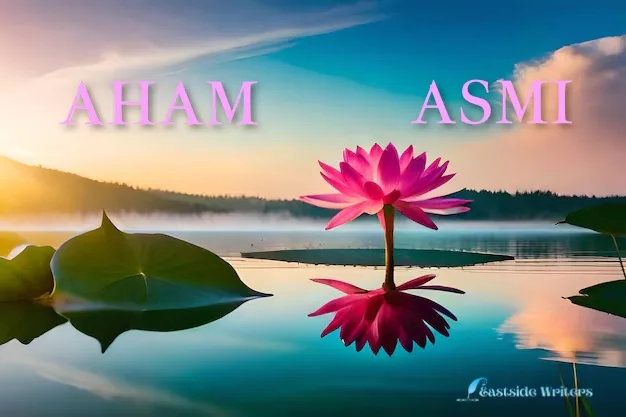Do you know the power of the phrase “Aham Asmi”? These two Sanskrit words, meaning “I am,” hold within them a profound truth that echoes across the spiritual and philosophical traditions of ancient India. They reflect the realization of self-awareness and connection to the universe. In today’s fast-paced world, where distractions and external validations constantly bombard us, the idea of turning inward and declaring “Aham Asmi” might seem foreign—but it is more relevant than ever.
“Aham Asmi” is not just a statement of existence; it is an affirmation of being. It represents the deeper layers of identity that transcend the surface-level definitions we often cling to—our jobs, relationships, and societal roles. To embrace “Aham Asmi” is to connect with the essence of who you are, beyond the material world, beyond the noise. It is a call to explore the self that is constant, the core that remains untouched by the chaos around us.
By embracing the concept of “Aham Asmi,” we begin to see life from a new perspective. It changes how we interact with others, how we face challenges, and how we pursue our goals. This simple yet profound phrase opens the door to a more authentic existence, where we live not from a place of fear or limitation but from the power of knowing that we are. This blog will explore the depths of what it means to say “Aham Asmi” and how it can transform your life.
Understanding “Aham Asmi” from a Spiritual Perspective
The Essence of Spiritual Awakening
From a spiritual perspective, “Aham Asmi” is not just an intellectual idea but a realization that shifts one’s perception of existence. In many spiritual traditions, the phrase signifies the ultimate truth that the self is not separate from the universe. When one declares “I am,” it is not merely a statement of personal identity but an acknowledgment of the infinite, boundless consciousness that resides within.
In Hindu philosophy, this aligns with the concept of Atman, the true self that is not confined by the physical body or ego. Atman is the essence of each individual, a reflection of the universal consciousness or Brahman. To say “Aham Asmi” is to recognize that the individual soul (Atman) is one with the universal soul (Brahman), leading to the realization of non-duality.

The Divine Nature of the Self
In the Upanishads, one of the core teachings is that the self is divine. The declaration “Aham Asmi” serves as a reminder that every individual carries within themselves a spark of the divine. This recognition of inner divinity is liberating, as it dissolves the illusion of separation from the source of all creation.
The spiritual journey, therefore, is not about acquiring something external but uncovering the divine nature that already exists within. “Aham Asmi” becomes the mantra for those seeking enlightenment, urging them to transcend the ego and experience their connection with the infinite.
Introspection and Spiritual Growth
The phrase “Aham Asmi” invites deep introspection. In order to fully grasp its meaning, one must embark on an inward journey to discover their true self, shedding layers of societal conditioning, fears, and false identities. Meditation, self-inquiry, and mindfulness are some of the tools that facilitate this introspective process.
As individuals explore their inner world, they begin to see the oneness of all things. They understand that the same divine force that animates them also animates the entire universe. This realization leads to a profound shift in consciousness, where the boundaries between the self and the world dissolve.
Psychological Understanding of “Aham Asmi”
The Search for Identity
From a psychological standpoint, “Aham Asmi” represents the core of human identity. In modern psychology, much of one’s life is spent constructing an identity based on external factors—career, relationships, achievements, and societal expectations. However, beneath these layers, there exists a more fundamental sense of self, one that is untouched by external circumstances.
Carl Jung, the influential psychologist, discussed the concept of the “Self” as the totality of the psyche. The journey to discover this Self, often called individuation, involves integrating different aspects of one’s personality and uncovering the deeper, authentic self that lies beyond the ego. In this context, “Aham Asmi” resonates as a declaration of this true self, a realization that transcends superficial identities.
The Power of Self-Affirmation
Psychologically, affirming “I am” can be a powerful tool for self-empowerment and healing. Positive affirmations have long been used in therapy to help individuals reshape their self-image and boost their confidence. However, “Aham Asmi” goes beyond mere affirmations—it is a recognition of existence itself.
When someone says “I am” with full awareness, they are not defining themselves by their roles, successes, or failures. Instead, they affirm their existence without conditions, acknowledging that their worth is intrinsic. This can lead to a healthier self-concept, where one is less dependent on external validation and more anchored in their inner sense of being.
Overcoming Psychological Limitations
By embracing the idea of “Aham Asmi,” individuals can also break free from limiting beliefs and mental conditioning that hold them back. Much of human suffering is rooted in identification with the ego, which thrives on comparison, fear, and insecurity. The ego constantly seeks to define itself in opposition to others, creating a sense of separation and inadequacy.
“Aham Asmi” challenges this narrative. It urges individuals to recognize their inherent worth and wholeness, independent of external validation. In doing so, it offers a path to overcoming negative self-talk, low self-esteem, and feelings of disconnection. It shifts the focus from “What do others think of me?” to “I am enough as I am.”
Philosophical Insights into “Aham Asmi”
The Nature of Existence
Philosophically, “Aham Asmi” opens up questions about the nature of existence itself. What does it mean to say “I am”? Who is the “I” in this statement? These are questions that have been explored by thinkers across various schools of thought, from existentialism to phenomenology to Vedanta.
In existential philosophy, the idea of “being” is central. Philosophers like Jean-Paul Sartre explored the concept of existence as something that precedes essence. This means that individuals are not born with a predetermined nature; instead, they create their essence through choices and actions. The declaration “Aham Asmi” in this light becomes a powerful assertion of free will and the responsibility to define one’s own identity and purpose.
Non-Duality and Oneness
In Vedanta, a school of Hindu philosophy, the concept of non-duality (Advaita) is key to understanding “Aham Asmi.” Advaita teaches that there is no real separation between the self and the universe; the perception of duality is an illusion created by the mind. “Aham Asmi” is a direct expression of this truth, signifying the realization that the individual self is not different from the universal self.
Philosophically, this understanding challenges the common perception of separateness. It invites individuals to see themselves not as isolated entities but as integral parts of a greater whole. The implications of this realization are profound, as it changes the way one interacts with the world. When the self is recognized as part of the universal consciousness, compassion, empathy, and a sense of interconnectedness naturally arise.
The Challenge of Self-Realization
While “Aham Asmi” offers profound insights, the journey to fully understand and embody it is not an easy one. Philosophically, it challenges individuals to confront the illusion of the ego and question deeply held beliefs about reality. It requires a willingness to let go of the need for external validation and to trust in one’s own inner truth.
In this sense, “Aham Asmi” is both an invitation and a challenge. It asks individuals to embrace the unknown, to dive into the depths of their own being, and to recognize the divine nature that resides within. This process of self-realization is not about reaching a final destination but about continuously expanding one’s awareness and understanding of the self.
What makes “Aham Asmi” so compelling

Aham Asmi so compelling due to its profound universality, transcending cultural and philosophical boundaries. Rooted in ancient Indian wisdom, the phrase “I am” speaks to a fundamental human quest for self-understanding and meaning that resonates across time and traditions. Whether in spiritual contexts, where it reflects the connection between the individual self and the divine, or in psychological frameworks that emphasize self-awareness and empowerment, “Aham Asmi” invites everyone to explore the true nature of their existence. It unites people in a shared search for purpose, identity, and fulfillment.
This universality is also reflected in the way “Aham Asmi” challenges individuals to recognize their inherent divinity and power. It affirms the idea that we are not just passive beings defined by external circumstances but are active creators of our reality. Across cultures, the phrase resonates as a call to introspection, encouraging individuals to embrace their inner potential and realize their connection with the larger universe. By affirming one’s existence, “Aham Asmi” transcends the boundaries of specific traditions and becomes a timeless, universal affirmation of self-worth and cosmic oneness.
The Cosmic Consciousness
In recognizing our connection to the universe, “Aham Asmi” also opens the door to the experience of cosmic consciousness. This term refers to the state of awareness where an individual transcends the ego and perceives the universal consciousness that permeates all things. It is the realization that the same force that animates the stars and galaxies also flows through us.
Through practices such as meditation, contemplation, and mindfulness, individuals can tap into this cosmic consciousness. This experience is often described as one of deep peace, clarity, and interconnectedness. In this state, the boundaries between the self and the universe dissolve, and one becomes aware of the infinite nature of existence.
Aligning with Universal Flow
As we deepen our connection with the universe, we begin to align with its natural flow. Instead of feeling separate or in conflict with the world, we learn to move in harmony with the rhythms of life. This alignment brings about a sense of ease and grace, as we no longer feel the need to control or force outcomes. We trust in the wisdom of the universe and allow ourselves to be guided by its flow.
This alignment with the universal flow also brings about synchronicities—moments where events or circumstances seem to fall into place effortlessly. When we are in tune with the universe, we attract opportunities, people, and experiences that support our growth and fulfillment. “Aham Asmi” becomes a reminder that we are part of this greater flow, and by staying connected to our true self, we naturally align with the divine order of the universe.
Transcending the Ego and Expanding Consciousness
The Illusion of Separateness
One of the key challenges on the journey of “Aham Asmi” is transcending the ego. The ego, with its need for control, validation, and distinction, creates the illusion that we are separate from the world around us. This illusion of separateness is the root cause of much suffering, as it fosters a sense of isolation, competition, and fear.
However, as we deepen our understanding of “Aham Asmi,” we begin to see through this illusion. We realize that the ego is not our true self, but rather a construct of the mind. By moving beyond the ego, we can expand our consciousness and experience the interconnectedness of all life.
Expanding Beyond the Individual Self
As we transcend the ego, our awareness naturally expands beyond the boundaries of the individual self. We start to perceive life from a broader, more universal perspective. In this expanded state of consciousness, we recognize that the same life force that animates us is present in all beings and all forms of existence.
This expanded consciousness brings about a sense of compassion and empathy for others. We no longer see ourselves as separate from others, but as part of a larger whole. This shift in perspective changes how we interact with the world, leading to more harmonious and loving relationships with others and with the planet.
Living from a Place of Unity and Purpose
Ultimately, the journey of “Aham Asmi” leads to a life of unity and purpose. When we recognize our oneness with the universe, we naturally feel a sense of responsibility for the well-being of all. Our actions become guided by a higher purpose, one that seeks to contribute to the greater good.
Living from this place of unity brings about a sense of fulfillment that is far deeper than any external achievement or success. It is a fulfillment that comes from knowing we are living in alignment with our true nature and with the flow of the universe. We move through life with a sense of peace, trust, and joy, knowing that we are always supported by the greater cosmic order.
Conclusion:
In a world where we are constantly encouraged to look outward for answers, validation, and fulfillment, the phrase “Aham Asmi” serves as a powerful reminder to turn inward. Whether approached from a spiritual, psychological, or philosophical perspective, the idea that “I am” invites introspection and self-discovery. It challenges individuals to recognize their own divinity and power, transcending the limitations imposed by the ego and societal expectations.
Aham Asmi” is more than a phrase—it is a journey of self-discovery, personal fulfillment, and universal connection. As we embark on this journey, we come to understand that our true self is not confined by the ego or external identities. We recognize our inherent worth and divinity, leading to a sense of personal fulfillment that is rooted in inner peace and wholeness.
At the same time, “Aham Asmi” reveals our deep connection with the universe. We are not separate from the world but are part of a greater whole, connected by the same universal consciousness. As we align with this cosmic flow, we experience a sense of harmony, purpose, and unity that transforms our lives.
The journey of “Aham Asmi” is ongoing, inviting us to continuously expand our awareness and deepen our connection with ourselves and the universe. It is a path that leads not only to personal growth but also to a profound understanding of our place in the cosmos.
Disclaimer: The author’s views are his or her own. The facts and opinions in the article have been taken from various articles and commentaries available in the online media and Eastside Writers nor the writer does not take any responsibility or obligation for them.
Note: Contact our Writers at www.eastsidewriters.com for writing Blogs/Articles on any niche. We have experts in various domains from Technology to Finance and from Spirituality to Lifestyle and Entertainment.







Pingback: From Ordinary to Truly Extraordinary: A Guide to Living Life to the Fullest - Eastside Writers